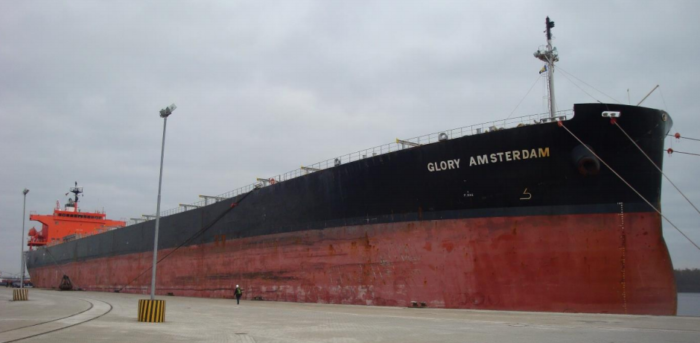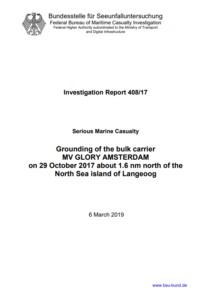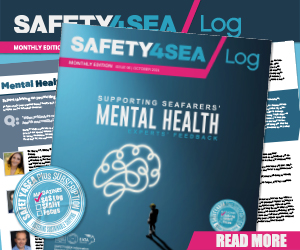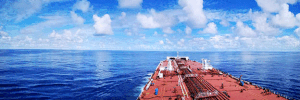The German Bureau of Maritime Casualty Investigation published its report on the Panama-registered bulk carrier Glory Amsterdam, which ran aground about 1.6 nm north of the German North Sea island of Langeoog.
The incident
The ship was sailing in ballast and in spite of two anchors being dropped drifting in a southerly direction from her anchor position, which was 18.5 nm from the subsequent scene of the accident, in hurricane force winds since early in the morning on the day of the accident. The Glory Amsterdam was waiting there for the next cargo order.
[smlsubform prepend=”GET THE SAFETY4SEA IN YOUR INBOX!” showname=false emailtxt=”” emailholder=”Enter your email address” showsubmit=true submittxt=”Submit” jsthanks=false thankyou=”Thank you for subscribing to our mailing list”]
The master notified the vessel traffic service (VTS) responsible for the area, German Bight Traffic (GBT), about his problems. He had already phoned the German agency that had supported his ship in Hamburg to request tug assistance.
Since the VTS had doubts with regard to the short-term availability of a suitable vessel, as the further course of events confirmed were justified, it took the precautionary measure of ordering the emergency towing vessel (ETV) Nordic, which was some 10 nm away from the Glory Amsterdam, to proceed to the distressed vessel by phone.
The tug arrived at the Glory Amsterdam and the master of the Nordic then repeatedly tried to explain to the master of the Glory Amsterdam on VHF radio – ultimately unsuccessfully due to considerable communication problems – that the Nordic is not the tug assistance requested by the Glory Amsterdam but an ETV, whose task is to establish a temporary towing connection to hold the distressed vessel in her position in an emergency.
Not least because of the considerable problems the Nordic and the VTS experienced while discussing the measures needed to manage the emergency situation with the Glory Amsterdam’s master in English, the Cuxhaven-based CCME3 decided to transfer the boarding team (BT) stationed on the Nordic (BT NORDIC) especially for such tasks to the distressed vessel to assist with communication and provide technical support during the necessary emergency towing operation.
Since the risk of the Glory Amsterdam running aground was increasing all the time, the VTS ordered the distressed vessel to slip her anchors and move to deeper water under her own steam.
The first, initially only sporadic indications of grounding were felt on board the Glory Amsterdam, causing, inter alia, the stern of the distressed vessel to occasionally settle on the sea floor. This caused a mechanical damage to the rudder blade and its support system, meaning the Glory Amsterdam had to be classified as completely not under command (NUC) from this point at the latest.
The Glory Amsterdam finally grounded in the area of the 5 m depth contour north of the island of Langeoog. Immediately arranged inspections on board revealed that the grounding had apparently not damaged the shell plating. At no time was water ingress or escaped pollutants detected.
Probable cause
The BSU reported that the ship’s command of the Glory Amsterdam had not unequivocally understood the Nordic’s mission and legal basis upon which she was operating at the scene, even when BT Baltic Sea arrived on the distressed vessel late that afternoon.
Throughout the day and depending on the situation, the ship’s master repeatedly wavered between the assumption that the NORDIC was the tug assistance he had ordered early that morning and the fear that the Nordic would act as a commercial salvage tug.
Recommendations
In the report, BSU proceeded to make the following suggestions:
- Nordic and other vessels chartered by the federal government and used on its behalf as ETVs should be furnished with the same colours and markings as the WSV vessels owned by the federal government. If current legislation does not permit such a measure, then the BMVI should work toward ensuring that the necessary legislative framework be established or amended accordingly as quickly as possible;
- The term ‘Boarding Team’ should be replaced by a designation which clearly indicates that its deployment pursues the non-commercial objective of maritime emergency preparedness and is on behalf of the state. This could be achieved by replacing the name ‘Boarding Team’ with ‘German Emergency Assistance Team’, for example;
- The CCME should have direct access to all AIS data and radar images available from the WSV in order to perform its tasks efficiently. The most practicable solution is to provide the CCME with an ECDIS system in which all AIS and radar data available within the WSV are implemented. Moreover, the technical prerequisites for enabling the CCME to participate passively and actively in VHF radio traffic in Germany’s territorial sea using the call sign assigned to it on 2 May 2016 by the Federal Network Agency (German Maritime Emergency Command) on the associated frequencies should be established immediately or finalised if already started. In this respect, the CCME’s coastal radio station should be enabled to use VHF channel 16 without restrictions and to monitor the VTS’s radio channels. Obstacles in terms of security or of a legal nature that would prevent access to AIS and radar data or to VHF radio traffic must be removed by the competent authorities;
- The BT should be equipped with long-range handheld radios and at least two satphones. The BT’s equipment should also include an internet-enabled, shockproof and at least splash-proof netbook;
- The safety strategy for the German coast should be amended to the effect that the GDWS or the competent WSA informs the CCME in good time if a multi-purpose vessel belonging to the WSV cannot be used as an ETV for several weeks or even months;
- The CCME should develop printed matter which in addition to legal information on the actions of the ETV and a BT should, in particular, contain a concise description of the steps needed to establish an emergency towing connection;
- The CCME should improve its procedures to ensure that the BT is provided with the most accurate knowledge of the distressed vessel’s condition possible and the specific task order before reaching the distressed vessel;
- Training on the operating procedures described in the ETB should be provided, as far as regular on-board operation permits.
For more information, click the PDF herebelow


































































